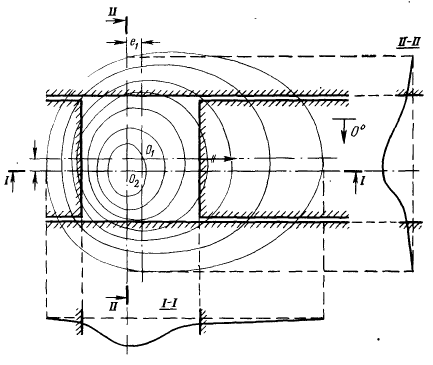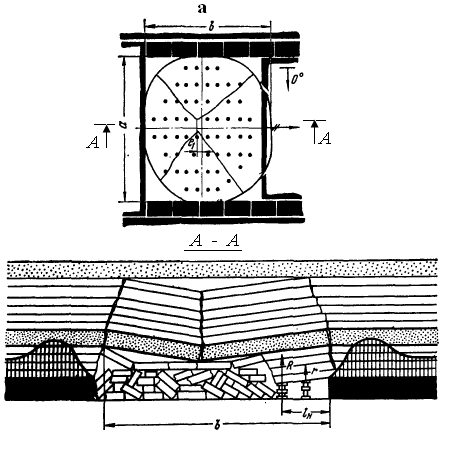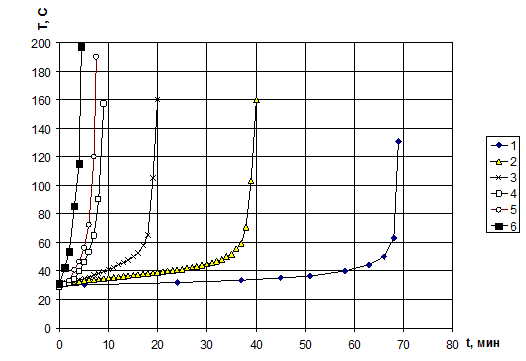Abstract
Content
- Introduction
- 1.Rationale and relevance of the topic
- 2. The purpose and objectives of the research, the expected results
- 3. Scientific novelty and practical value of the work
- 4. A review of existing research and development on
- 5. Current and future results of research on the topic
- list of sources
1. Rationale and relevance of the topic
Modern coal mining conditions are accompanied by a number of negative manifestations of rock pressure. Especially when mining coal at depths greater than 800m. Work carried out in a burst-formation at high methane natural, high temperatures, etc. In these circumstances, the use of modern mechanized complexes issue of security operations at the primary landing in the working face of the roof is quite relevant, especially in terms of trudnoobrushaemyh roofs.
In primary landing roof normally observed cracking and coal extraction at the bottom of the lava fall out in the toe section, floor wooden struts mounting due to increased overburden pressure amplifying floor racks are mounted on the roadway for 12 -45 m from the lava. When planting in the emergency mode (for large lockups) observed landing on the roof supports rigid base, a strong deformation of the roadways, the significant fall out on the lava.
Existing methods of softening trudnoobrushaemyh rocks are mainly associated with blasting operations. Blasting operations in the preliminary softening of trudnoobrushaemyh roofs limited outburst layers, and when forced collapse of the lava rocks for non-gas mines.
Therefore the question of developing a method for the primary landing of the roof in the working face at the expense of non-explosive rock destruction and justification of its parameters Fidler is a scientific challenge.
2. The purpose and objectives of the research, the expected results
The purpose of: justification parameters forced the collapse of the roof rocks with non-explosive mixtures destructive (LDCs).
The idea of ??working: is to prevent deadlocks roof rocks in the goaf lavas, which can lead to negative consequences, by forcing the collapse of rock from the mined-out space with the LDCs.
The problem is solved in the master's work:
- A method of forced collapse trudnoobrushaemyh rocks at the primary landing
- Laboratory studies of the method of initiation charge of LDCs in the well when forced landing of the roof.
- Laboratory studies have suggested soposoba prinuditelnoy landing models.
The object of study: coal mass array accommodating mining.
Subject of study: fracture processes trudnoobrushaemyh roof rocks by LDCs at the initiation of borehole charges.
methods of research: systematization and analysis, modeling equivalent materials, bench testing, a method of statistical analysis of the data.
3. Scientific novelty and practical value of the work
The scientific novelty of this work is as follows:
- for the first time, an analytical dependence of the pressure and the self-expansion of the phase state of hydration products of LDCs at the initiation of their work with the help of an electric field.
- the patterns of change in the workings of the displacements at different stage of the primary landing.
The practical value of the work: to provide a method of forced non-explosive collapse of rocks in the primary landing.
4. A review of existing research and development on the subject.
In the practice of mining developed several hypotheses rock pressure, displacement of the rock mass, which are based mainly on the findings of the phenomenological [1-9].. However, the diversity of geological conditions of coal seams, and the physical and mechanical characteristics of the rock mass reduces the possibility of hypotheses in other areas of the field, and even a mine field. With increasing depth development forecast error in the calculation of these hypotheses has been growing.
The rapid development in the second half of the twentieth century, new techniques, studies of the behavior containing file [10]. in natural conditions, physical modeling of the behavior of rocks on the models of equivalent materials[11]., optical modeling of rock pressure in clearing faces[12]. and other methods of laboratory research has made it possible to establish the nature of displacement of rocks over the open area.
Silo laboratory research and on physical models found that the work of immediate and main roof similar to the operation of thin and thick plates clamped along the contour, with three and two sides [13]..In the main roof is allocated two modes. The first mode of initial motion covers the period from the split of the oven before the first collapse of the main roof.
In the first mode (initial motion), there is some asymmetry in the bend of the main roof along the strike of the formation. Isoline curves shown in Fig. 1. On the left side of the split furnace concentration contours more on one foot than in front of a moving stope. The main character of the first collapse of the roof and the subsequent sinking of the dynamics shown in Fig. 2.
Currently, as a result of shifting research enclosing the coal seams of the array over the open area under natural (mine) the conditions set layered character of deformation of rocks. According to the strain rate within the excavation lava fields emit the zone of influence of treatment works and the zone of influence out space on the character of shifting rocks. The problem of prediction of rock pressure around the stopes by scientists IFGP NASU (14,15).

Fig.
1 –The nature of the deformation of the main roof before the first of its collapse [13].

Fig.
2 –The nature and form of the first main roof collapses
Studies have found that when trudnoobrushayuschihsya roofs resistance affects the lining stress state and the bundle only the lower layers up to 2 m increases resistance lining has almost no effect on the stress state of more distant layers and hang trudnoobrushayuschihsya rocks. Therefore, we can conclude that the management trudnoobrushayuschimisya roofs by increasing the resistance lining will be ineffective
In the coal industry to improve the efficiency of the management of heavy rocks roofs are several ways to use its weakening.
Known, and the following basic ways of softening of the roof to reduce the pressure on the safety of mining pillars:
-way of undermining;
-unloading of large diameter wells;
-advanced torpedoing;
-hydrotreating;
-gidromikrotorpedirovanie;
-vzryvogidroobrabotka;
-forced the collapse of the roof blasting hole charges;
-forced the collapse of the roof blasting shpurovyh charges;
-downhole vzryvopodbutovka;
-wedge destruction;
-directional hydraulic fracturing.
The purpose of the application of these methods is the reduction or complete elimination of the gravity of rock pressure on the safety pillars and roofs manifestations of sediment in a dynamic form.
The most widely used methods were:
The forward torpedo.
Summary of the process - local (local) strong attenuation of rocks in front of the main roof of stope along the length of the field or area excavation by blasting explosive charges in long wells. Formed as a result of the explosion artificial stress raisers in the form of zones of radial cracks and broken contacts in bedding planes as they approach the working face to the plane of torpedoing and its subsequent transition to a changing force field strains of the rock cracks grow into the trunk. Last dismember the main roof rock mass into blocks of height and bedding, ensuring its smooth descent as mining.
Dimensions cracking and fracture zones between the contacts durable layers depend on the type of explosive, rate of loading, the mass and charge of the downhole structure, physico-mechanical properties and parameters of stress waves.
As a result of the weakening trudnoobrushayuschiesya rocks are subdivided into smaller units. This leads to a drastic reduction in the intensity and severity of the manifestations of primary and secondary sludge main roof, to a decrease of active external loads on the supports of stopes and unloading their marginal parts.
Forced collapse of the roof hole charges
The method consists in planting trudnoobrushayuschihsya rocks over the open area to a height of 10 m by blasting explosive charges in holes drilled parallel to the working face. Roofing by blasting will separate its subsequent collapse. This eliminates the air strikes and the formation of large resistive loads on the lining.
Compulsory primary blast-hole charges planting explosives in the mined-out space is used only in the mines, no hazardous gas and dust explosion.
Thus, these methods are very limited in scope Donbass.
In the master's work is offered as a means of destruction of rocks to use LDCs.
In today's domestic and foreign practice has a long experience of using non-explosive mixtures destructive (LDCs). The use of the LDCs in the construction industry associated with the elimination of concrete support structures and foundations working in shops and other facilities during their reconstruction [16]., in road construction - with the destruction of asphalt pavement[17]. etc. The main advantage is the absence of non-explosive destruction of a sound effect, scattering pieces of the destroyed object, the possibility of destruction near heavy equipment and people without changing the process. The most important practical problem of application of LDCs in underground mines is a time management failure breeds. Hydration rate control is currently carried out mainly through the use of chemical additives, having an exothermic reaction with the calcium oxide, but in this case the acceleration of the reaction occurs immediately after mixing. Thus, the preparation of one portion of the mixture for loading a large number of holes is difficult. Since during loading LDC holes in a container with the prepared mixture, the hydration reaction also proceeds, and with greater speed than in the hole, because of the large quantity of substance, and various boundary conditions (heat absorption and heat conductivity). This can lead to uncontrolled increase of the reaction rate and the phase transition LDC directly in the vessel or in unsealed boreholes during loading. That reduces the performance and safety of the work, and may contribute to accidents. Thus, there arises the need of mixing small portions, which increases the complexity of the work time on loading holes. At the same time ensuring the accuracy of alternating destruction remains essentially unsolved problem.
Search control method of hydration of the LDCs to achieve the necessary order the destruction of rocks along the lines of holes, which would reduce the destruction of rocks from underground mines is an important scientific task. An important point in practicing the preparation is necessary for all LDCs number of holes, their loading, and only then the initiation of a fracture in the desired order
5. The current and planned results of research on the topic
To study the characteristics of LDCs under the influence of an electric current laboratory studies were performed in which a sample of LDCs cylindrical shape with a base diameter of the cylinder 40 mm and a length of 60mm, simulating a fragment of charge in a hole to pass a current of different voltage. In this case, the change in temperature recorded LDCs through electronic laboratory thermometers DM-9231A.
Voltage regulation is carried out in a range of 5-70V with a laboratory autotransformer LATR 2.5, which is designed for variable voltage AC at 50 or 60 Hz. For short-circuit protection LATR included in the network, which is protected by fuses with a current of 10A fuse. When the voltage above 70V in the experiments, the distance between the electrodes l = 6cm, burn out the fuse link. The experimental setup is shown in Figure 3.

Fig.
3 –Setup for the study of the effect of electric current on the hydration rate of the LDCs
1–sample of LDCs
During a first phase of the experiment samples of LDC in air with a temperature of 25 0C were obtained graphs of a change in the temperature of the mixture under the influence of time on the sample with different electric voltages (Fig. 4). Reference sample for comparison was selected sample of LDCs, through which current is passed. From the graphs can be seen that for all samples the rise rate of hydration when exposed to electricity compared to the baseline sample. Increasing the voltage over 20V when the distance between the electrodes 6cm leads to acceleration of the reaction is more than 10 times. Tension in 20 or more triggers the mixture for 10 minutes or less.

Fig
4 –Graphs mixture temperature changes over time when exposed to a sample with a voltage of electricity
1 – 0В, 2 – 5В, 3 – 10В, 4 – 20В, 5 – 30В, 6 – 40В
Quantitative evaluation of the resulting acceleration effect of hydration reaction mixture is proposed to conduct by a factor of acceleration equal to the ratio of time spent 1 and 2 stages of hydration[18]. для базового образца к аналогичному времени для образца, на который воздействует электрический ток (рис. 3). Полученные данные хорошо аппроксимируются экспоненциальной зависимостью , с коэффициентом корреляции 0,987. Из полученных результатов видно, что при воздействии напряжения в диапазоне 5-60В скорость реакции повышается до 300 раз. Полученные результаты показали принципиальную возможность управления скорость гидратации НРС воздействием электрического тока. Таким образом, было установлено, что с помощью электричества можно инициировать интенсификацию работу НРС.for the base model to the same time for a sample which is exposed to an electric current (Fig. 3). The data obtained are well approximated by an exponential relationship, with a correlation coefficient of 0.987. The obtained results show that under the influence of voltage in the range of 5-60V reaction rate is increased to 300. The results show schematic control over the rate of hydration LDC electrical stimulation. Thus, it was found that using electricity can initiate work intensification LDCs.
The main prospect research is the possibility of using the results of the work in the coal industry of Ukraine
Literature
- Борисов А.А. Расчеты горного давления в лавах пологих пластов. – М.: Недра, 1964. – 278 с.
- Слесарев В.Д. Управление горным давлением при разработке угольных пластов Донецкого бассейна. – М.: Углетехиздат, 1952. – 350 с.
- Кузнецов Г.Н. Взаимодействие боковых пород и крепи в очистных выработках пологопадающих пластов каменного угля. – В сб. «Исследования по вопросам маркшейдерского дела», № ХХVII, Углетехиздат, 1953. – с.31-42
- Руппенейт К.В. Давление и смещение горных пород в лавах пологопадающих пластов. Углетехиздат, 1957. – 233с.
- Панов А.Д., Руппенейт К.В., Либерман Ю.М. Гор¬ное давление в очистных и подготовительных выработках. Госгортехиздат, 1959. – 247с.
- Орлов А.А., Сетков З.Ю. и др. Взаимодействие механизированных крепей с кровлей. М., «Недра», 1976, 336 с.
- Давидянц В.Т., Измерения проявлений горного давления на шахтах Донецкого бассейна/ В.Т. Давидянц., Г.Л. Козелев.-Углетехиздат,1952,– 116с.
- Лабасс А. Управление кровлей посредством обрушения. Междуна¬родная конференция по горному давлению. Углетехиздат, 1957.
- Феннер Р. Исследование горного давления. «Глюкауф», 1938, № 32 и 33
- Петухов И.М. Методы изучения сдвижения горных пород и угля в массиве. М., Углетехиздат, 1954. – 35 с..
- Кузнецов Г.Н. Моделирование проявлений горного давления. – М.: Недра, 1964. – 420 с.
- Трумбачев В.Ф. Исследование горного давления в очистных выработках оптическим методом. М., Углетехиздат, 1955. – 99 с.
- . Борисов А.А. Механика горных пород и массивов. М., Недра, 1980.–360с.
- Лобков Н.И. Определение параметров обрушения трудноуправляемой кровли влавах пологих пластов Донбасса/Н.И. Лобков, А.И. Сергиенко,Е.Н. Халимендиков. В сб. Физико-технические проблемы горного производства/Вып.№12.Под общей редакцией А.Д. Алексеева.Донецк: ИФГП НАНУ, 2009. –с. 113-123.
- Лобков Н.И. К вопросу о механизме формирования горного давления в лавах пологих пластов. В сб. Физико-технические проблемы горного производства/Вып.№6.Под общей редакцией А.Д.Алексеева.-Донецк: ООО“Апекс”,2003.-с.81-87.
- Галкин, В.В. Невзрывной способ разрушения строительных конструкций при реконструкции зданий / В.В.Галкин, А. Г. Потапов // Монтажные и специальные работы в строительстве. 1983.- № 6.- С. 21-22.
- Заявка 57-119850, Япония, МКИ В 02 С 19/18, Е 04 С 23/08. Композиция для разрушения бетона, дорожного покрытия и т.п. / Нисихара Акио, Мива Мотому, Тада Сюити; Асахи дэнка коге к.к. № 56-5779 заявл. 16.01.81,. опубл. 26.07.82.
- Касьян Н.Н. Обоснование методов управления скоростью роста распорно-компрессионных характеристик невзрывчатых разрушающих веществ / Н.Н. Касьян, И.Г. Сахно, Я.О. Шуляк / Вісті Донецького гірничого інституту. – 2010. - №2. – С. 209-219.
